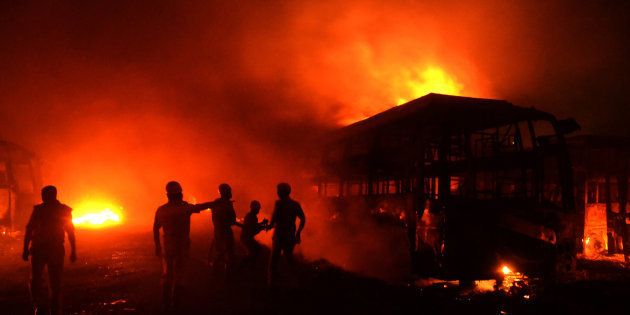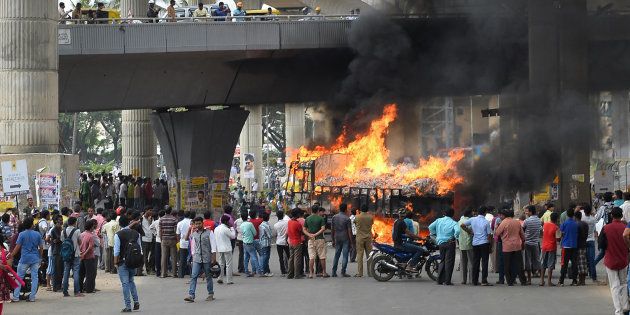
On Monday, Bengaluru saw for itself how Kannada activism has been hijacked. The preserve of intellectuals till the 1980s, it has progressively been lumpenised. Drawing on the Shiv Sena model of sub-nationalism and extortion to fuel itself, it culminated in manic Monday when competing groups out to control Bengaluru decided to log it out of its global image as India's Silicon Valley.
In a matter of a few hours, Bengaluru crashed into a deep gorge, a valley of fear and despair.
Over 500 people have been detained by the Bengaluru police in the last 24 hours. A majority of them rowdy sheeters in the city, mainly operating out of the northern and eastern parts of Bengaluru. On Monday, they had worked in tandem, converting areas in north and south-west Bengaluru into a theatre of arson, loot and destruction.
Over the past few years, several fringe groups have spread their tentacles in Bengaluru, in the garb of protecting Kannadiga pride. Carrying the red and yellow Kannada flag, the bigger groups are Karnataka Rakshana Vedike, Jaya Karnataka, Kannada Okkoota and Kannada Sena. But as the workload to carry out assignments grew, they have also grown amoeba-like into several smaller branches, available for a hit on speed dial.
It is only ironic that in outsourcing city Bengaluru, the task to derail Bengaluru is outsourced by shady political operators to these roll-call outfits. Bengaluru today is run by these people, whose groups have a track record of fomenting trouble at the drop of a coin.
Vatal Nagaraj is the most visible of these fringe group leaders, a rent-a-cause activist with the dubious claim of having organised over 10,000 protests in the last four decades. This maverick was the most visible face during the Karnataka bandh last week, his protest gulping the tonic of linguistic chauvinism to indulge in rabble-rousing. He took on Biocon chief Kiran Mazumdar Shaw for her sarcastic tweet that Bengaluru should be renamed "Bandh-luru" and warned that anyone living in Karnataka will have to toe its line.

Narayana Gowda heads Karnataka Rakshana Vedike, which agitates on issues as diverse as jobs for Kannadigas, imposition of English over Kannada, Cauvery dispute or Karnataka's border disputes. His Vokkaliga credentials helps him bond with politicians of the same caste, who have turned a blind eye to the Vedike's over-the-top activities.
There are others, with more shades of grey. Muthappa Rai, who heads Jaya Karnataka, was allegedly once a Dawood Ibrahim aide and reportedly involved in several murders. He was arrested in 2002 and extradited from Dubai and was described by filmmaker Ramgopal Varma as the "Bahubali of the underworld". His outfit's website claims a membership of over 7 lakh.
Sridhar, popularly referred to as "Agni" Sridhar, is a former rowdy, who now claims to be an intellectual. He even wrote a script based on the Bengaluru crime scene and directed a Kannada film Thamassu in 2010. His Kannada Sene, established six years ago, has taken on Shiv Sena in the Karnataka-Maharashtra border districts to assert Kannada supremacy.
Most of the youth are aged between 25 and 30 and are either daily wage labourers, construction workers or small-time property dealers. The red and yellow scarf around their neck turns them into a warrior on the street.
It now transpires that the Karnataka bandh on Friday was largely a Nagaraj and Karnataka Rakshana Vedike show, both scoring high on TRPs of a different kind — Turmoil Rating Points. With the Vedike and Jaya Karnataka in direct competition to control Bengaluru, Monday's violence was the result of competition between these fringe groups taking its toll on the city.
Senior police officers confirm that a majority of those picked up owe allegiance to these three outfits, even though all these fringe groups deny any hand in the violence. Most of the youth are aged between 25 and 30 and are either daily wage labourers, construction workers or small-time property dealers. The red and yellow scarf around their neck turns them into a warrior on the street.
Over the years, these fringe groups, emboldened by political protection, freelance for anyone who wants to use their services for a cause or against a rival. Many of them are known to run protection services, like mafia gangs, dividing Bengaluru into zones and areas. They also make their money on big-ticket land deals. Which is why the red and yellow flag today is used by shopkeepers not as a symbol of pride in being a Kannadiga but more to ward off troublemakers.
Senior police officers say this "parallel policing ends up enhancing the brand equity of these hoodlum gangs". Contrast it with how Bengaluru's brand equity has taken a hit with images of arson going viral. The fear factor that Monday has created, most feel, will come in handy when the groups go to collect funds from commercial establishments in the run-up to Karnataka Rajyotsav (Karnataka Formation Day) on 1 November.
The present situation gives Karnataka police an excellent opportunity to purge Bengaluru of these elements. All it needs to do is to seize the cellphones of those detained, peruse their call records, find out who called who in the 72 hours between Friday and Monday and connect the dots. The question is whether the black sheep in the political establishment will greenlight the action plan.
In 2009, when Shankar Bidari was Bengaluru's top cop, the police decided to call the Kannada outfits' bluff and cracked down on them. But in the last two years, they have gained strength again. "The party in power in Karnataka — irrespective of who it is — is apprehensive about taking them on because they fear it will be perceived as anti-Kannada. So, no clear cut orders are given and the police keep waiting," says a senior officer.
The fear factor that Monday has created, most feel, will come in handy when the groups go to collect funds from commercial establishments in the run-up to Karnataka Rajyotsav (Karnataka Formation Day) on 1 November.
The fact is not one but two Bengalurus exist. It suits everyone to showcase only the magnificent Vidhana Soudha, MG Road, Commercial Street and Electronic City as the real Bengaluru. Unfortunately, it also survives cheek-by-jowl with its seedy Siamese twin, which thrives on divisiveness and rancour.
So the "this is not the Bengaluru I know" line is only for those who ignored these faultlines that exist in Karnataka's capital, like in any other developing city. Time for the political and police leadership to draw the Laxman rekha and tell these troublemakers of Bengaluru — This far and no further.
Also on HuffPost:
